Choosing a van for your campervan conversion can be very intimidating. With the sheer number of models available, it’s hard to know where to begin. But, this post gives practical advice for narrowing down your search quickly. Once you identify your specific needs, you will know confidently how to choose a van for a campervan conversion.
I share brief descriptions of all the options. Then help you narrow it down by addressing specific questions you may have (i.e. new or used, high-roof vs low-roof, mileage, collision history, and lots more).
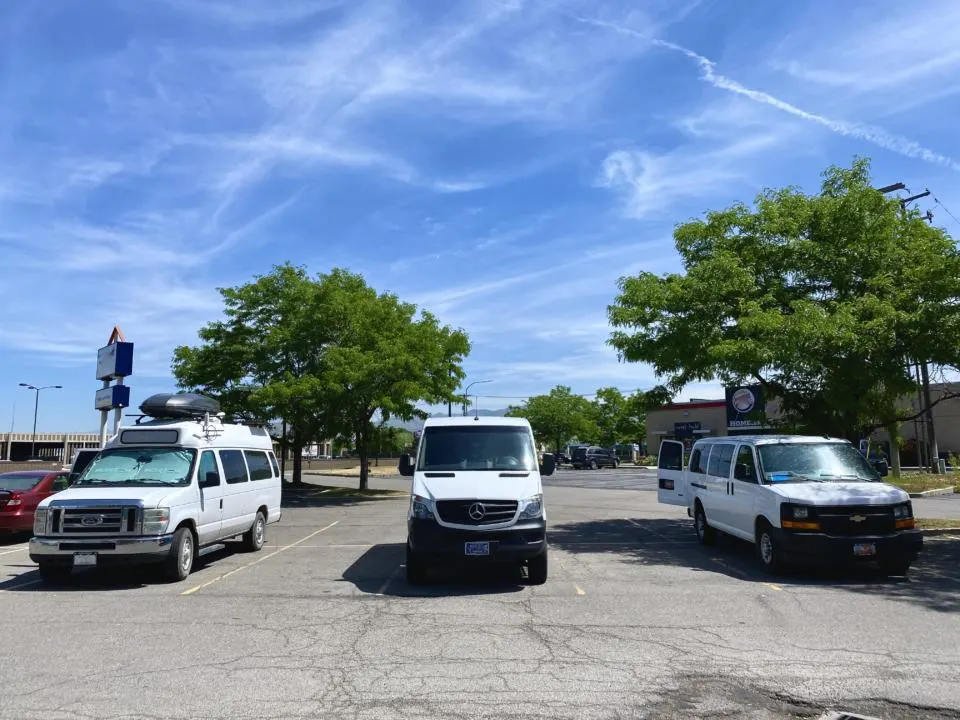
This post may contain affiliate links. Disclosure policy.
Our Philosophy For Choosing A Van
Vanlife is about freedom. So don’t choose a van that makes you less free.
What do I mean by that?
I mean don’t buy a van that becomes a financial burden. If you buy a van that is too expensive and you cannot reasonably afford it, then you may be stuck making payments that put tremendous pressure on your life.
Conversely, if you buy a van that’s too cheap, then you might be stuck spending too much money on repairs.
When planning to convert a van, starting with a good base van is important. You don’t want to put time and money into converting a van that is a dud. With the extra investment in your conversion costs, you want to have confidence that your van can go the distance!
When you convert a van, you are taking a risk by investing money into the conversion costs. The cost of your conversion should be somewhat tied to your confidence level in the van itself.
You wouldn’t do a million-dollar renovation on a house if you knew that the foundation was faulty. Same with van conversions.
If you plan to spend thousands of dollars on your conversion, then you better make sure you have a good level of confidence in your base van. However, if you’re going for a low-budget conversion, then it’s fine to take a little more risk on an older van.
But you will need to make your own judgment on this risk assessment, based on your total budget and your plans.
What Are Your Plans?
Basically, step one for deciding how to choose a van, is being honest about your intentions. Because campervan owners come in many different flavors. So what are your plans?
Are you planning to move into your campervan full-time and fully embrace the nomadic lifestyle? Or are you simply planning a short-term road trip, with intentions of moving back into a house/apartment at the end of that trip?
Is your campervan just a fun toy that you can take on weekend adventures? Or is it going to be your full-time home?
What features MUST your campervan have? (solar power, desk, toilet, kitchen, bike storage, etc.)
The answers to these questions should help you determine how much money you need to spend to create your dream campervan.
But of course, you will have to balance this against what you can reasonably afford.
Overcoming The Fear
I remember when we were shopping for our first van, we felt immense pressure to find the perfect van. We were scared of choosing the wrong van and then wasting our money on a conversion.
These fears are totally normal. But don’t worry. With proper planning and good common sense, you can find the right van for you.
Our advice is: Don’t get too bogged down in the details. Don’t become obsessed with one brand or specific feature.
The most important thing is finding a van that fits your budget, meets your basic criteria, and is in good mechanical shape.
Still not sure if Vanlife is for you?
Check out my post about:
Overview Of Vans In The U.S.
Emily and I live in the US, so this post is geared towards the most common vans available in the US.
Here’s a quick overview of vans available (pardon my biases).
Full-Size Vans
While not a strict category, “Full-Size” vans are usually large, boxy vehicles with a platform and drivetrain similar (or identical) to trucks. Most high-dollar modern campervan conversions are built in a full-size van. (Think large bed, kitchen, bench, bathroom, shower, etc.)
Mercedes-Benz Sprinter
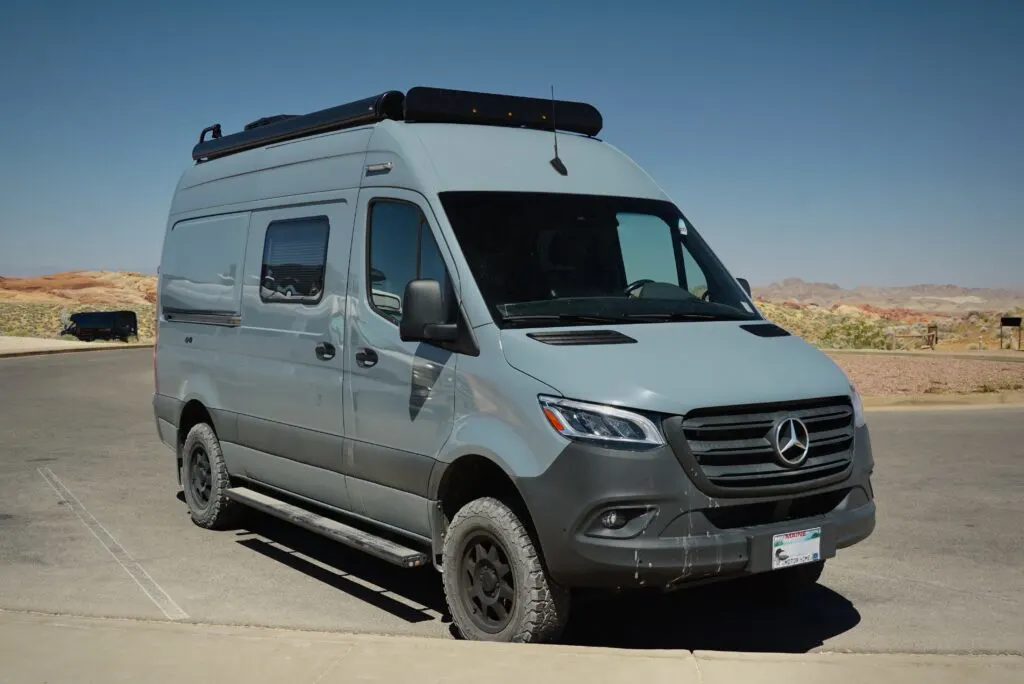
Starting with the most expensive is the Mercedes Sprinter. As the only full-size van available in 4×4, and with a roomy/boxy interior, it’s a very desirable van for van conversions. But be prepared to pay the premium price. They are expensive to purchase and maintain.
(For several years the Sprinter was assembled in the US by Dodge and Freightliner to avoid an import tax. So you may see early 2000s Sprinters with those logos, but they are basically the same. Wait, what’s the difference?).
Ford Transit + Ram Promaster
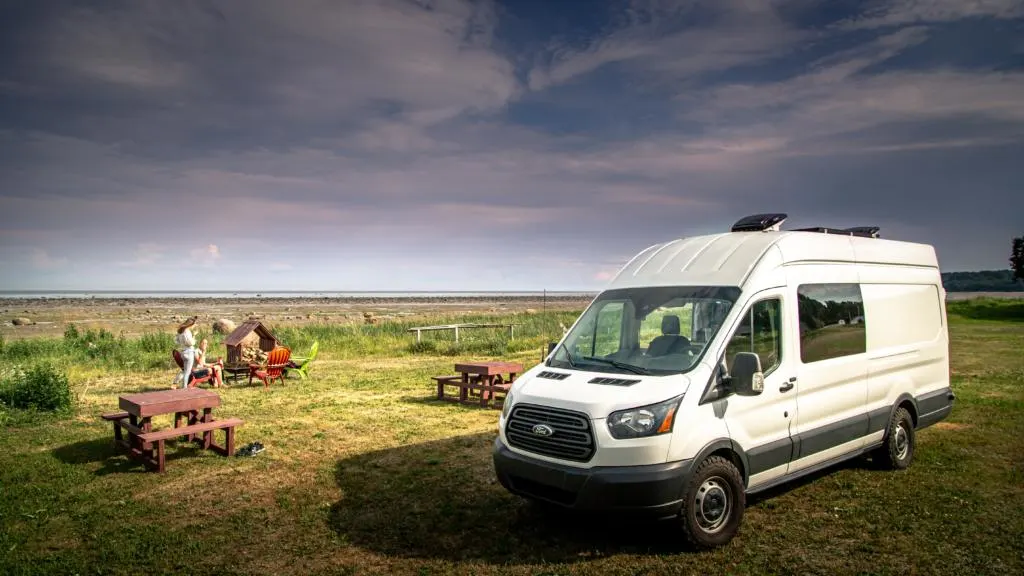
The next tier down are the Ford Transit and RAM Promaster. These American vans are designed to compete with the Mercedes Sprinter by offering a “Euro-style” van with a big boxy interior.
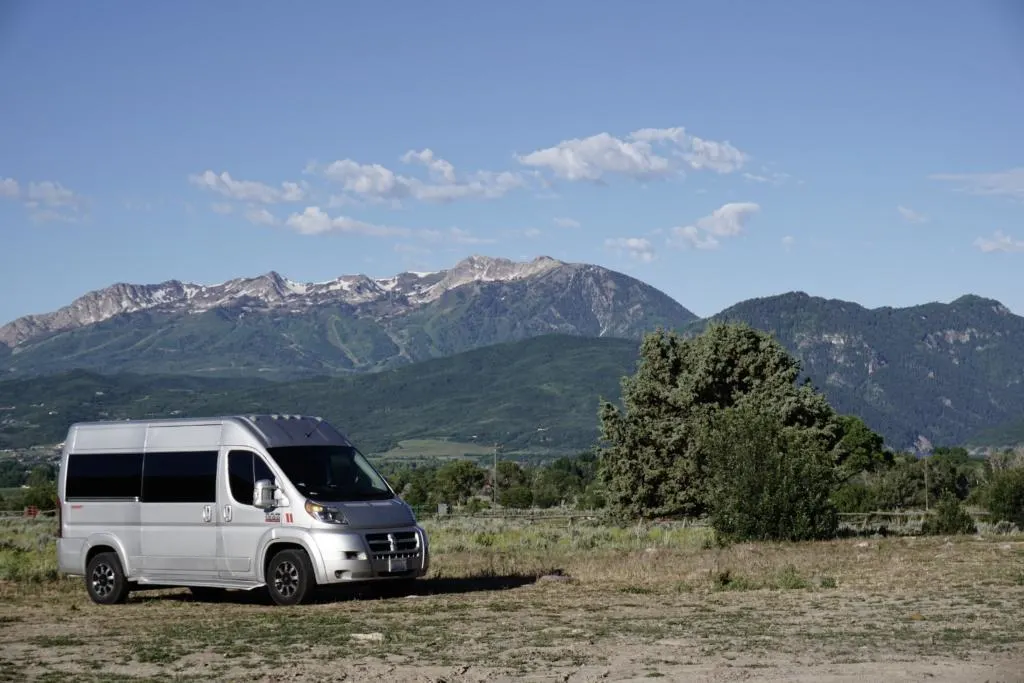
One really notable difference is that the Promaster is FWD, but the Ford Transit is RWD or AWD. They are cheaper to buy and maintain than a Mercedes Sprinter.
But since they were only introduced in 2013, they still carry a good amount of their initial price tag in the used market.
Classic American Work Vans
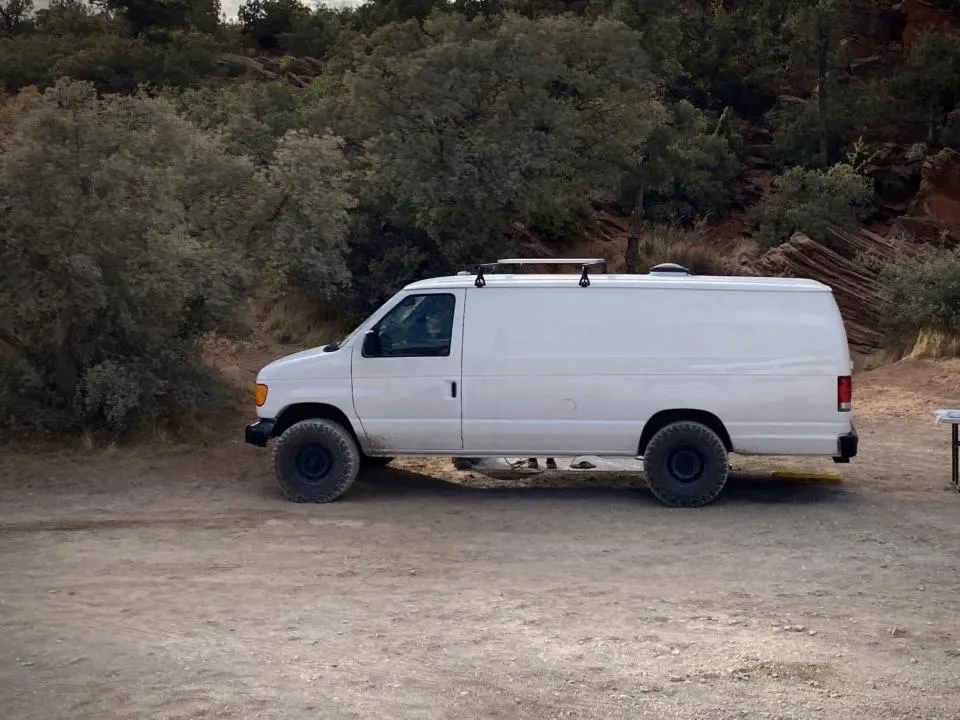
This next tier comprises the vast majority of all vans in the US. It consists of the Ford E-Series (formerly Econoline), Chevy Express (formerly Chevy Van), GMC Savana (formerly Vandura), and the Dodge Ram Van.
The first three (Ford, Chevy, GMC) are extremely similar in build, specs, and available models. For now, you should basically just consider them interchangeable. (Chevy and GMC are both made by General Motors, so they are literally mechanically identical).
But Dodge is kind of the odd man out because the Dodge Ram Van has a unibody construction rather than a body-on-frame construction like the other three. (If that makes no sense to you, don’t worry, we can get into the finer details later).
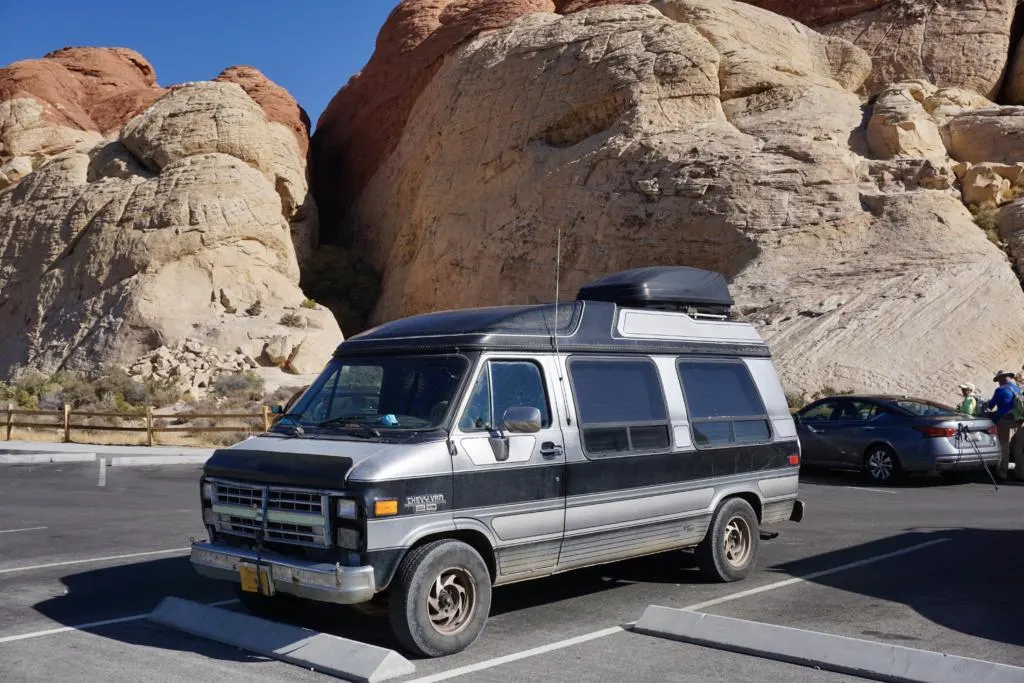
There is a large subset of this category that encompasses the wide variety of older conversion vans, and campervans. These aftermarket conversions are a bit of mixed bag because different companies were involved in converting these vans from their stock form into a conversion/camper van.
The conversion typically includes an aftermarket fiberglass roof, windows, custom upholstery, captain’s chairs, and other lifestyle furnishings to make the van more “liveable”. They generally use a Ford, Chevy, GMC, or Dodge work van as the base, and range from about the 1970s through the 2000s. However, depending on age, most of them will require decent renovation/remodel.
Nissan NV
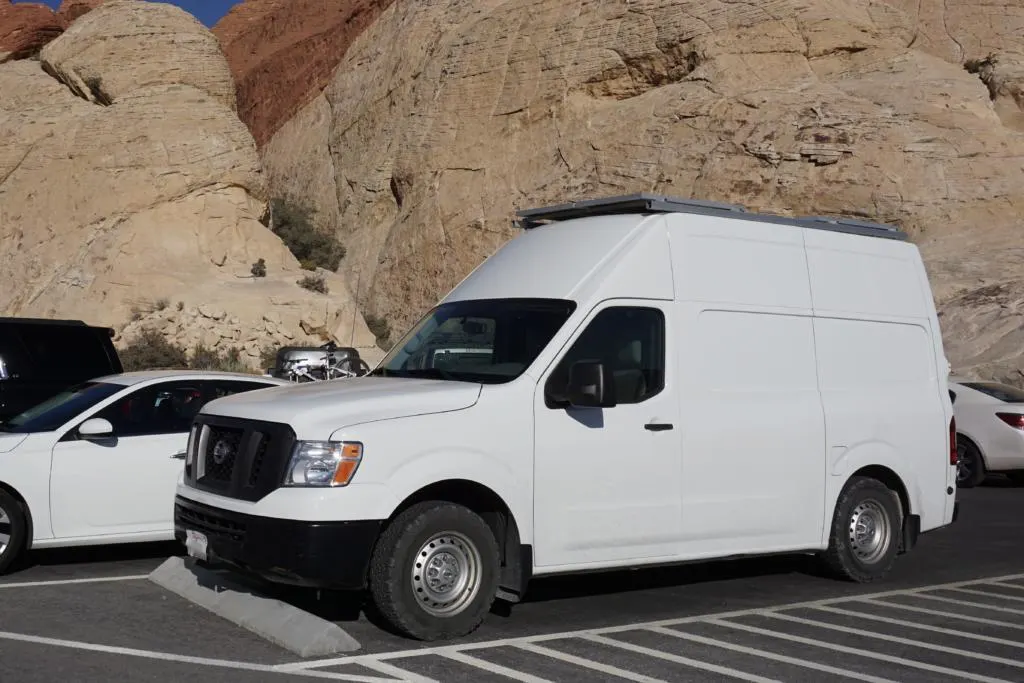
In 2012 Nissan unveiled their own cargo van called the Nissan NV Cargo. It’s similar to the Ford, Chevy, GMC vans with a body-on-frame style. But a notable difference is that it’s available in high-roof models, making it a sort of awkward hybrid between Euro-style and classic American van.
As of 2021, the Nissan NV and smaller city version NV200 have been discontinued. But for what it’s worth, it has better towing capacity than all the competition.
Smaller Vans
Chevy Astro & GMC Safari
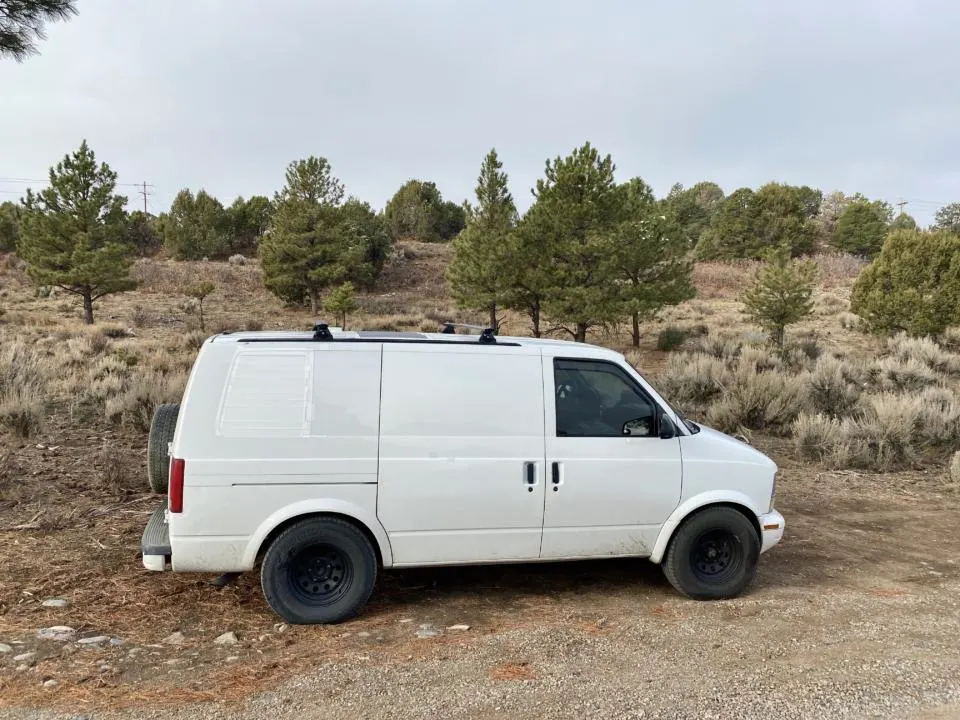
The Chevy Astro (AKA Astrovan) and GMC Safari (both made by General Motors) are completely identical except for branding and cosmetics.
They were in production from 1985-2005.
They still have a strong cult following that appreciates these unique little vans for their good size-to-cargo ratio and MPG. But probably the most notable thing in the context of campervans is that beginning in 1992, they were offered in AWD.
Volkswagen Bus / Vanagon (Westfalia)
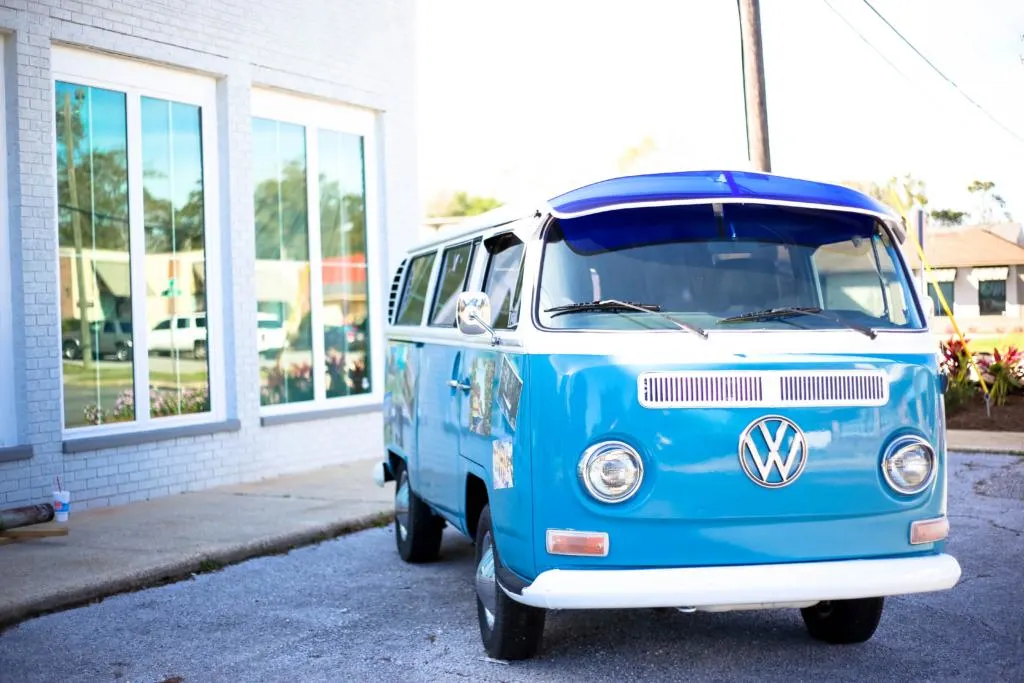
The classic Volkswagen bus is basically the originator of the campervan. You know, hippies, counter-culture, blah blah blah.
This tradition has continued with the late generation Volkswagen Vanagon, which has been famously converted into the well-known pop-top campervans called a Westfalia (or Westy). Not all Vanagons are Westfalias.
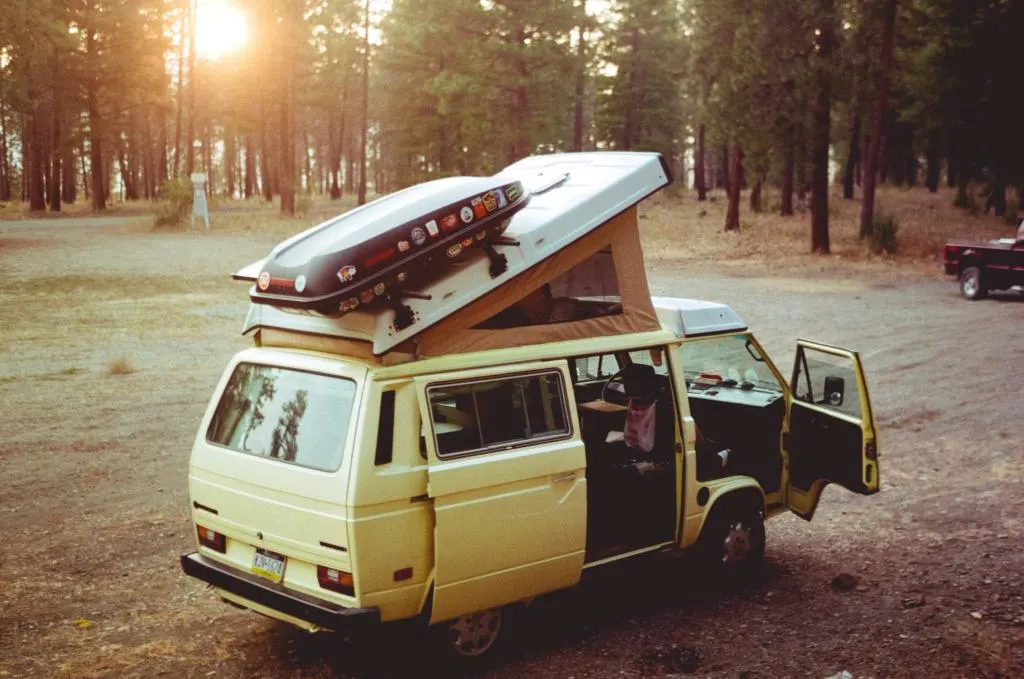
Photo by Nick Dunlap on Unsplash
VW buses and Westies are still around, but demand for these niche vehicles makes the price pretty steep for what you get.
They aren’t very big and are expensive to buy and own. Either someone has put lots of work in and expects a pretty penny, or it’s cheaper but is overdue for lots of work. However, they are a good fit for DIY mechanical work, because they have minimal electronics and computerization.
Small City Vans (Ford Transit Connect, Promaster City, etc)
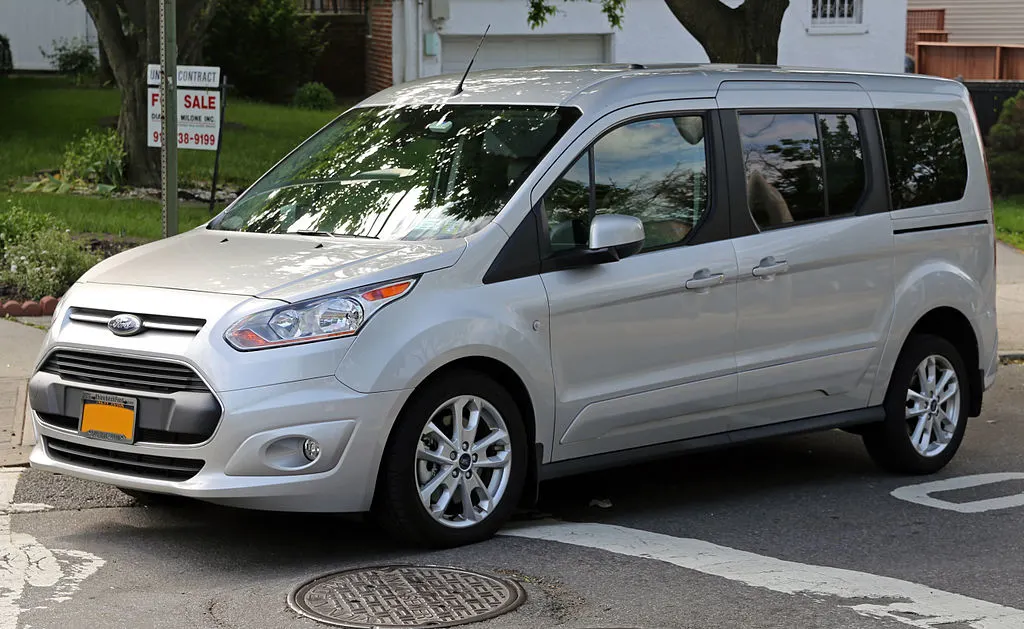
The last category of vans available in the US is the small city-centric vans or compact vans.
This category includes Ford Transit Connect, RAM Promaster City, Mercedes Metris, Nissan NV200, and Chevy City Express. (As of 2023, all of these vans have been discontinued).
Generally, they are a little small for a complete campervan conversion, because there’s barely enough room for a bed, let alone much else. But that doesn’t mean mini conversions don’t exist. Check out these awesome Nissan NV200 Micro Camper Conversions.
But they are significantly cheaper than their full-size counterparts. Maintenance and parts are cheap (because they are basically cars). And they get better MPG than any other vans on the list. So for those who can handle the minimal size, there are some unique benefits.
I hope I haven’t lost you yet. But those are pretty much the main options for vans in the US.
It’s not really that long of a list.
So how can you decide which is best for you?
What Factors Should You Consider?
These are the most important things to consider when deciding how to choose a van for a campervan conversion. (You can click items in this menu to jump to a particular section)
Table Of Contents
- New vs. Used
- Size
- Cargo vs. Passenger
- Payload
- Mileage
- MPG
- Drivetrain
- Reliability / Parts
- Gas vs. Diesel
- Safety
- Budget
New Or Used?
I cannot recommend ever buying a new van (or any new vehicle). New vehicles generally don’t return value to the buyer unless you keep the vehicle for 10 years or more.
If that is your plan, then you may get your money’s worth from a new van.
Dealerships will try to tempt you with their warranties and other shiny objects, don’t fall for it. They need to offer something to lure people into making the terrible decision of buying a new vehicle.
Many vans are very dependable, long-lasting vehicles that can keep running long after the original owner.
So buying a used van is (in my opinion) the way to go. Plus, you can reallocate all the money you save from buying used towards your conversion costs.
However, buying a used van doesn’t come without risk.
Buying used from a private seller (AKA Joe Schmo on Craigslist) is usually the cheapest route, but also carries the most risk. Buying used from a dealership usually comes with a little more assurance (but not always).
When buying a used van. The most important things you can do are get a vehicle history report, a Pre-Purchase Inspection (PPI), and inspect and test-drive the van yourself.
If you’re still not sure, read our detailed guide about Buying A New vs Used Campervan.
What Size Van Do You Need?
How much space do you need for your conversion? Are you planning to use the van solo, or do you have a partner or dog?
And what about personal items (bikes, guitars, clothing, skis, or whatever hobbies you plan to bring along). You’re going to need space to fit your desired lifestyle into the van.
But keep in mind that there is always a trade-off between size and other factors (i.e. cost, MPG, maneuverability, parts/maintenance). So in this case, bigger doesn’t always equal better.
And if you really need lots of space, maybe you should consider a class-B or class-C RV or school bus instead.
When choosing a van to buy, the two main dimensions to consider are height and length. But width may also be a consideration depending on the conversion layout.
Height
Do you need to be able to stand up in your van? Then you will need something tall enough, but obviously, that depends on your height.
Generally, more height is better because it just makes the van more comfortable to live in, and increases overall space.
However, the taller a van is inside, the taller it will be overall. And having a really tall van may prevent you from accessing certain places (most commonly, drive-thrus and parking garages). And if you plan to add things like vent fans, solar panels, or gear racks, they will add even more to your total height.
Another downside of height is that it makes the van harder to drive in windy conditions. Really tall vans have a tendency to get pushed around on highways by wind or draft from semi trucks.
Sprinter or Euro-Style
If you’re over 6 feet tall then your best bet is to get a euro-style van. The most iconic is the Mercedes Sprinter, but Ford Transit and RAM Promaster are also comparable in interior height. And while not quite equivalent, I’m gonna include the Nissan NV in this category because it comes in a high-top option from the factory.
Aftermarket High-top Vans
If you are shorter than 6 feet, you may be able to stand in non euro-style van with an aftermarket high-top. That means that they weren’t manufactured with a high-roof, but someone modified them by adding a taller roof.
The height of aftermarket high-tops may vary significantly, so be sure to investigate the interior height. Generally, they aren’t quite as tall as Euro-style vans, but not always.
Vans with aftermarket high-tops are a bit of a mixed bag, but they mainly include conversion vans, shuttles, ambulances, handicap-accessible, etc. The base vans for these modifications are usually domestic vans. To review, anytime you see me say “domestic”, I’m usually referring to the classic American work vans made by Ford, Chevy, GMC, and Dodge.
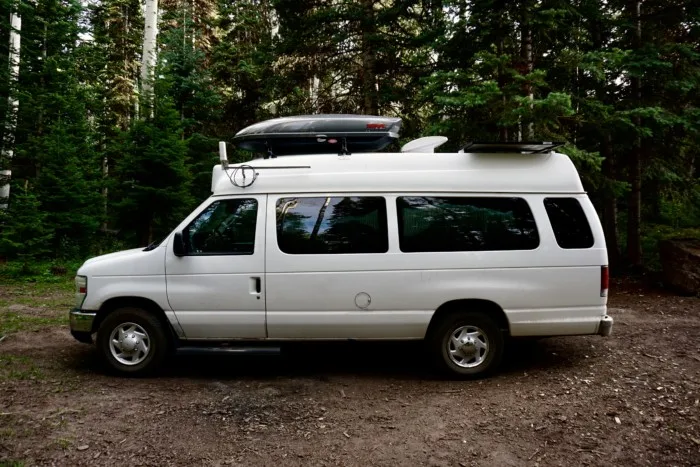
Our van fits into this category. It’s a 2010 Ford E-350 passenger van that was converted into a hotel/airport shuttle.
This conversion included a fiberglass hightop that makes the van’s interior height about 5’10” (with insulation, ceiling, and floor). So for myself at 5’8”, it gives me just enough room to stand.
Ideally, one would aim for a little bit more headroom, but we thought our van was a great value, so we’re happy to deal with the minimal clearance.
I’ve written a whole post about Why Choose A Fiberglass Hightop Van For A Campervan Conversion.
Or you can buy a low-roof van and have a specialized company add an aftermarket hightop for you. The most well-known company that does this is Fiberine in Los Angeles, CA. For 30 years they have specialized in aftermarket fiberglass high-tops, but be prepared to fork over 3-4 thousand dollars for the job. When factored into your budget, it may still be a good option for some people.
Pop-Top Campers
And then there are pop-top campers. Pop-top vans can convert between high-roof and low-roof with a mechanism that allows the roof to “pop” up and down.
The most common versions of these are Volkswagen Vanagon Westfalia Pop-Top Campers and Sportsmobile Campervan Conversions.
Low-Roof Vans
If you don’t need to be able to stand, then you can purchase a “low-roof” van. But be prepared for lots of squatting and sitting in your van. This includes all stock domestic vans, like the Ford Econoline, Chevy Express, GMC Savanna, and Dodge Ram Van.
And there are even low-roof models of Mercedes Sprinter, Ford Transit, RAM Promaster, and Nissan NV. However it’s not common for people to purchase these for van conversions because you pay the majority of the premium price without receiving one of the primary benefits (high roof).
The other low-roof vans are the Ford Transit Connect, Ram Promaster City, Nissan NV200, Chevy Astro, GMC Safari and unmodified Volkswagen vans/busses.
All things being equal, you can usually find low-roof vans for much cheaper than their high-roof counterparts.
Low-roof vans are just so abundant, especially the pre-2013 Ford, Chevy, GMC, and Dodge full-size vans. They are also so ubiquitous that parts are abundant and most mechanics know how to work on them.
Length
While height is often the more important dimension that people care about, don’t ignore the length.
The benefits of a longer van are pretty obvious. There’s simply more interior space for your conversion. It may provide the extra space you need to have a proper kitchen or table, or bench, etc. It also means that your roof is larger for things like racks and solar panels.
The negatives of a longer van are that it’s just a bigger vehicle overall. That means more weight, sometimes more expensive parts, possibly worse gas mileage, and less maneuverability.
Longer vans are worse for off-road driving when abrupt pitch changes are involved. Or you might have issues fitting into a normal parking spot, especially if you have any racks on the front or back.
If you plan to be primarily in cities, I would highly suggest avoiding any extra-long vans. Or even look towards the smaller vans. Parking in cities is hard enough, so you want to be able to fit in normal length parking spots.
The two primary ways that manufacturers differentiate between model lengths is by referring to the “wheel-base” (distance between the front and rear axle), or simply calling the longer version “Extended”.
For example, Mercedes Sprinter is available in 144” wheel base, 170” wheel base, and 170” WB extended.
Whereas the old Ford E-series vans (Econoline) are available in either regular or extended versions (both 138” wheelbase).
Width
While width isn’t usually a huge factor when you choose a van, it might be a potential tie-breaker between similar vans.
Practically speaking, the biggest concern regarding width is whether or not you can fit your bed width-wise, rather than length-wise.
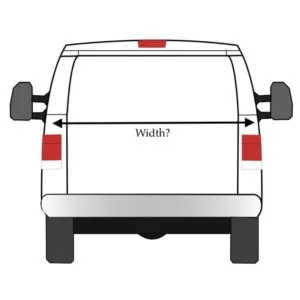
Because sleeping width-wise in a van is a game of inches. If you’re 6 feet tall (72 inches), then the difference between a Sprinter/Transit ≈ 70″ and a Promaster’s width – 75.6″ can make all the difference. (Read: Can You Sleep Sideways In A Van).
Full-Size Vans Width = usually between 70″ to 75″.
Small Vans Width = usually between 60″ – 69″.
But keep in mind that those figures are measured at the absolute widest point, usually the “beltline” about halfway up the van.
So you have to mount your bed at exactly that height to capitalize on that width. And that doesn’t account for insulation, walls, etc, which also may reduce the total “liveable” width.
Another practical consideration is that Euro-style vans (Sprinter, Transit, Promaster) have less variance in width than the older classic American work vans (Ford Econoline, Chevy Express, GMC Savana).
That is, the classic American vans are rounder, becoming significantly more narrow at the floor and ceiling.
Euro-style vans don’t narrow as much as you approach the ceiling. Plus, the boxier shape of euro-style vans is one feature that makes them much easier to convert.
Cargo Van Or Passenger Van
Most vans are offered in both cargo and passenger models.
Cargo Vans
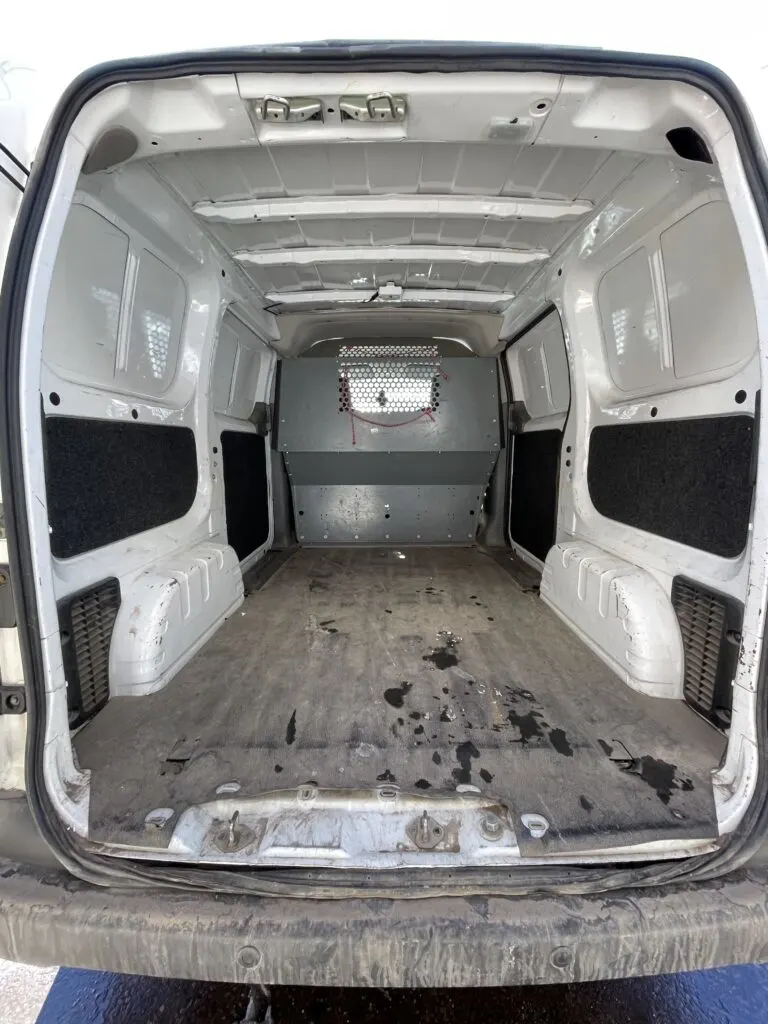
Cargo vans are the typical “work van” and are usually just an empty metal shell in the rear with little to no windows. They offer a complete blank slate for owners to customize any way they choose.
This makes cargo vans a good fit for campervan conversions because you are ready to convert right away. However, if you buy used, the former owner may have racks or shelving installed for their business needs.
Fewer windows makes the van easier to insulate, so cargo vans are better for colder climates. And having fewer windows provides more security and privacy to the inside of the van.
It is possible to add aftermarket windows to cargo vans. They usually cost around several hundred dollars plus a relatively easy DIY installation.
Passenger Vans
Passenger vans, sometimes called wagons, are usually equipped with many seats for passengers and windows around the entire van. They also have the rear interior finished with flooring, upholstery, climate control, and electronics.
This creates an extra step to begin conversion because you need to gut the interior.
The additional windows are better for letting natural light into the van. But more windows also means worse insulation and less security.
More windows also leads to less privacy if you don’t make covers/curtains. And even with insulating window covers, the windows will almost inevitably be the weakest point in your insulation.
Another negative of windows is that it means less wall space. In a small living space, having less wall space can be a significant challenge. It means less space to mount shelves, cabinets, hooks, electronic displays/monitors, etc.
I’ve mentioned insulation several times in this post. But the topic of campervan insulation is quite in-depth. So check out our discussion all the best materials and techniques in our Campervan Insulation Guide.
Payload
Payload refers to how much weight a vehicle can carry. You should make sure that your van can handle the weight of your conversion.
Exceeding payload can distress suspension, blow tires, ruin handling, reduce MPG, and harm the engine or transmission.
A campervan conversion that consists of mostly wood furniture will be much heavier than a conversion that uses lightweight materials like aluminum, foam, or composites.
The other common heavy items to consider are batteries, water tanks, and appliances.
Generally, the vans with the smallest payload to be cautious around are Volkswagen Vanagon, and the compact city vans (Ford Transit Connect, RAM Promaster City, Nissan NV200).
Manufacturers will often call the different models by increasing numbers to indicate how much they can carry. This can mean, bigger engine, more heavy-duty components, suspension, etc.
For example: Ford E-350 can carry more than Ford E-250, which can carry more than Ford E-150 (Complete guide to Ford E-Series Vans).
And most other full-size vans have a similar system (i.e. Chevy Express 1500, 2500, & 3500). And as a side note, the more heavy-duty vans tend to last longer with heavier loads and thus have better resale value.
Just make sure you don’t confuse Payload and Gross Vehicle Weight Rating (G.V.W.R.). The GVWR includes the weight of the vehicle when empty (curb weight). So you need to subtract the curb weight from the GVWR to get the payload.
For Example: Our 2010 Ford E-350 Super-Duty Extended. GVWR = 9,100lbs, Curb-weight = 6,448lbs.
Payload = 2,652lbs. (9,100 – 6448 = 2,652)
Our completed van+conversion weighs about 8,000lbs, so our total conversion weighs about 1,500lbs. Both metrics are safely under the payload and GVWR.
Luckily, bigger vans generally have higher payloads, so this problem is somewhat self-regulating. But you may still need to pay attention depending on your plans.
Mileage
How many miles should you be looking for when buying a used van? This is one of the most common questions that people ask when buying a used van.
Well, in general, fewer miles are better than more (as long as it’s not a lemon).
And like all used vehicles, generally the fewer miles the more it will cost to buy. But hopefully you will save money on repairs and maintenance.
Or you can shop for vans with higher mileage to try to find good value in an older vehicle.
The good news is that many vans have a much longer lifespan than your average passenger car. It’s not rare for an average full-size van to go to 250,000 miles without too much trouble.
So even if you buy a van with 100k miles, you might be able to get another 150k miles without needing a major engine or transmission overhaul.
Diesel engines are known for lasting even longer (300-400k miles).
But you will have to be honest with yourself about how many miles you want to drive your van. Obviously, someone who drives from Florida to Alaska every year will be driving way more miles than a weekend warrior who just travels locally.
You also should consider the cost of your conversion against the mileage on the van. For an extreme example, don’t buy an old van with 350k miles and then spend 15 thousand dollars on a conversion. Because when that van starts to crap out shortly after, your 15k conversion is now tied to a dying van.
So you need to make a value/risk decision about how much money you’re willing to invest in a certain vehicle.
Reliability / Parts
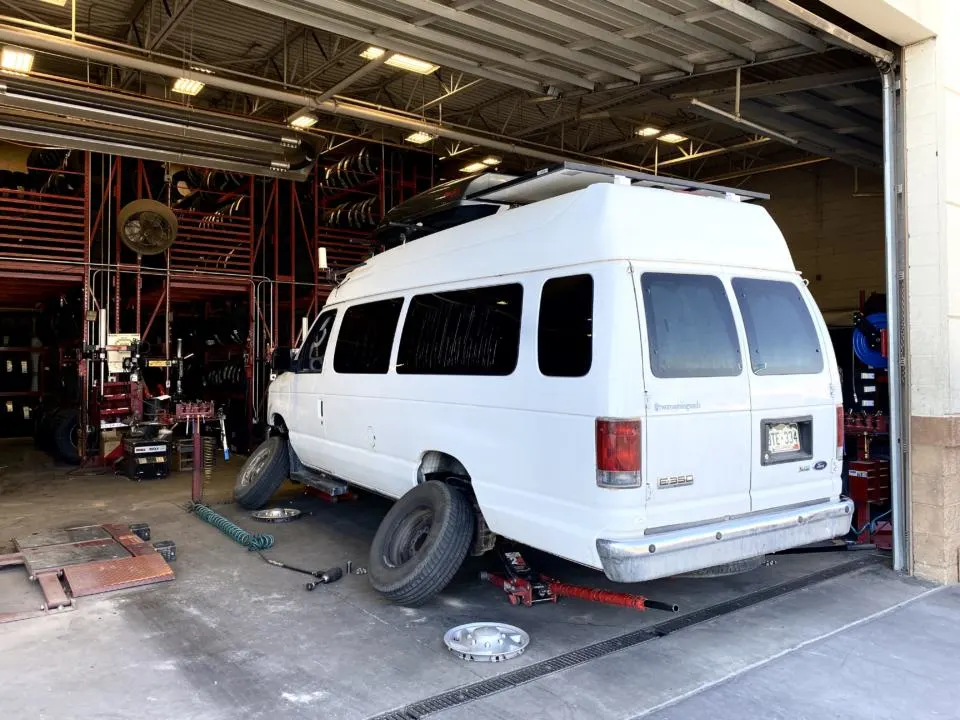
A good rule of thumb is that newer vans or vans with low mileage will need fewer expensive repairs. Although be skeptical of old vans with low mileage, that’s a red flag that it could be a dud.
Not all brands are equal when it comes to parts and maintenance. In the US, you are much better off with a domestic van (Ford, Chevy, GMC, Dodge). They are pretty reliable and maintenance is cheaper. And parts are easy to find.
Mercedes Sprinters are harder and more expensive to service in the US. After about 2006, they started to have complicated electronics that only Mercedes dealerships can service.
And dealerships charge much more than your average auto shop. And MB dealerships are basically only found in large cities and towns.
The Ford Transit and Dodge Promaster are both easier and cheaper to service in the US than a Sprinter. The Ford Transit is slightly cheaper than the Promaster, and so far has proved to be more reliable.
Volkswagens are also expensive to service in the US. They tend to be older vehicles that are starting to fall apart. Luckily parts are relatively abundant.
Are you handy with automobiles? If you are confident to fix problems as they arise, then you may be more comfortable buying an older van with more miles.
Also older vehicles (pre 2000) are easier to work on because they have little to no electronics.
However, don’t let your confidence with working on vehicles steer you into buying a problem van. Because ultimately, you should still be trying to find a van that doesn’t have any problems.
If you have found a specific van, try googling the make, model, and year to see if there are any major red flags with that particular van in that year.
At the very least, you can plan for these common problems, and factor them into your budget.
Miles Per Gallon (MPG)
The sad news is that most campervans get poor MPG. It requires a lot of fuel to move a heavy vehicle, plain and simple.
But the good news is that van MPG is improving steadily over time. So newer vans tend to get better gas mileage than older ones. And also smaller and lighter campervans will generally get better MPG than big heavy ones.
It’s a little tricky to provide exact MPG numbers for each van because there are so many factors. Especially once a van has been converted, you may get much different MPG than what the manufacturer claims. So ACTUAL mpg numbers are sometimes rather anecdotal.
Things that affect MPG
- Having exterior additions (solar panels, roof racks, bike racks, and vent fans, etc)
- Where you drive (sea level vs mountains, city vs highway)
- Changes to tires, suspension, etc.
- The weight of your conversion materials
- Using air-conditioning
So here’s a simplified breakdown of general MPG categories (i.e. what you can expect in the real world).
Full-Size Vans
Mercedes Sprinter = 14-21 mpg
Ford Transit / RAM Promaster = 12-18 mpg
Classic American Work Vans = 10-16 mpg
Nissan NV = 10-14 mpg
Small Vans
Transit Connect / Promaster City = 21-26 mpg
Chevy Astro / GMC Safari = 15-20 mpg
Volkswagen Vanagon = 15-20 mpg
Here’s a website that allows users to submit their “real-world” mpg results. Have a look if you want to get into the finer details of certain years, engines, and configurations.
Drivetrain (4×4, 2WD, etc.)
Drivetrain refers to how the van transfers power to its wheels. Basically, is it four-wheel drive or two-wheel drive?
Two-wheel drive vans are either front-wheel drive (FWD) or rear-wheel drive (RWD).
Four-wheel drive vans are either four-wheel drive (4×4) or all-wheel drive (AWD).
Front-Wheel Drive vs. Rear-Wheel Drive
I will frame this debate as it pertains to large, heavy vehicles since we are talking about vans.
Rear-wheel drive is better for towing and climbing steep grades. It’s the same reason that most trucks are RWD because the weight tends to be in the back when towing or carrying a heavy load. RWD is also generally simpler for mechanics to work on since the front wheels only steer and the rear wheels only provide power.
Front-wheel drive has more interior space, better mpg, and better traction*.
* FWD has become the more common drivetrain in modern cars because the heavier weight of the engine is over the front wheels and that results in better traction. However, with campervans, there is usually lots of weight on both the front and rear wheels. So the argument for better traction becomes a little less clear.
But FWD vans have more cargo space than a similar RWD van because there is no driveshaft passing under the vehicle. For example, the Dodge Promaster (FWD) has a lower “floor” than the Ford Transit (RWD).
Four-Wheel Drive Vs Two-Wheel Drive
You have to consider if you really need 4-wheel or all-wheel drive for your campervan.
If you plan on driving through snow, mud, sand, dirt roads, or off-road then you may benefit from having the added traction and control of 4WD or AWD.
However, AWD and especially 4×4 will significantly increase the price of a vehicle. If you MUST HAVE 4WD or AWD, then it will greatly narrow your buying options because most vans are 2WD.
So you will have to decide if it’s worth it for you.
4×4 versus AWD (All-Wheel Drive)
Both 4WD and AWD allow your vehicle to provide power to all four wheels. This can improve traction and handling in all kinds of adverse conditions. But here is how the two systems differ.
AWD systems are almost always automatic. Meaning that you don’t need to worry about turning it on and off. The vehicle will engage AWD when more traction is needed. And it’s designed for continuous operation on pavement. There is usually a fuel economy penalty associated with AWD systems.
This makes AWD the better option for casual drivers looking for increased safety when driving in unpredictable conditions like snow, ice, and rain.
True 4WD systems, however, must be manually engaged by the driver. But the vehicle is capable of operating in a normal 2WD setting for pavement and high-traction surfaces.
The ability to have 2WD helps with fuel economy. And they usually have an option for a 4WD low gearing that is especially helpful for achieving maximum torque.
4WD is generally better for off-road driving in more rugged and low-traction conditions. It is not good for continuous use on pavement because it doesn’t account for wheel spin variation when cornering.
So 4×4 is great for drivers who can identify specific adverse driving conditions ahead of time.
For example, when approaching a steep rocky incline on a dirt road, or a section of deep mud or sand, the 4WD owner can selectively engage 4WD just to conquer these specific obstacles. Then when conditions improve, they can switch back to 2WD.
For this reason, AWD is usually the better option for overall safety on pavement because it works automatically. While 4WD is generally better for off-road driving when looking for maximum torque to conquer specific obstacles.
We find that 4×4/AWD is slightly overrated when it comes to van conversions. That’s not to say that it’s not a great feature, but rather that for many people it’s not worth the price.
This comes from our first-hand experience of driving our rear-wheel-drive campervan over thousands of miles of dirt roads. We have handled all kinds of rough, steep, rocky, and sandy roads. Sure, there have been times when we decided to turn around, or park and continue on foot.
But we can probably count the number of times RWD has prevented us from doing something on one hand. And since July 2019, we have only gotten stuck a handful of times. And never so bad that we couldn’t get out on our own.
Check out our most recommended off-roading equipment. We highly recommend that all campervans have safety and recovery gear regardless of the drivetrain type.
So it really comes down to how you plan to use your campervan.
– Strictly driving on pavement and never seeing snow = 2WD for sure
– Driving dirt roads just to get from A to B (campsites, hikes, etc), and mostly avoiding snow = 2WD probably okay
– Plan to drive dirt roads and/or lots of driving snowy roads = AWD
– Plan to drive the most aggressive dirt roads or off-road entirely = 4×4
Aftermarket 4×4 Conversion
It is possible to have a 2WD van converted into 4×4 by certain specialized companies. Probably the most well-known one is Quigley in Pennsylvania. They will convert Ford, Chevy, GMC and Nissan vans into a true 4-wheel drive system.
Other companies: Agile Offroad, Ujoint, or Advanced4x4Vans.
But hold onto your seat because the cost of a conversion like this is usually $10,000-14,000 dollars! That will make most people think really hard if 4×4 is absolutely necessary.
Gas Or Diesel Vans
Some people make a big deal about gas vans versus diesel vans.
And some of the arguments circle around fuel efficiency, maintenance costs, longevity, and resale value. A big one is that Diesel engines get more MPG, however, typically an increase in fuel cost basically cancels out the benefit.
Feel free to do additional research on specific brands. But honestly, I don’t find any of the arguments to be compelling enough to make it a primary factor for how to choose a van.
I would consider it maybe more of a potential tie-breaker between two similar vans that meet your other more important criteria.
But here’s a quick oversimplified breakdown.
Gas = cheaper parts/maintenance, better for emissions, quieter
Diesel = more power, longer life, better resale value
Personally, I don’t like that diesel vehicles are louder and more smelly.
Safety
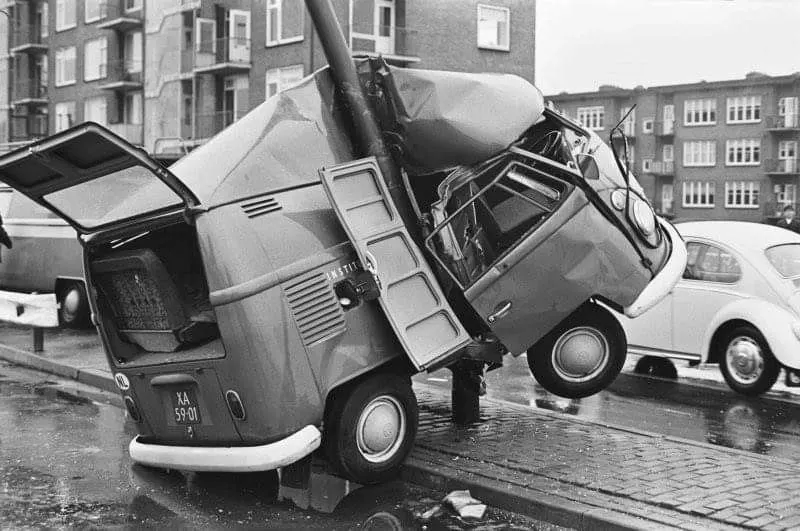
Simply put, newer vans are safer than older ones.
Ideally you want to choose a van with seatbelts, headrests, and airbags, which luckily is basically any van built after 1980. It’s just common sense at this point, hence why all modern vehicles have them.
The major outlier in the van market is old Volkswagens. They have a uniquely unsafe design because the hood is basically non-existent, meaning that a front impact can crumple directly onto your legs. And they were also late adopters of seatbelts and headrests.
Budget
Ahhh yes, budget…. For most of us, it’s the key limiting factor on which van we buy.
And the range is ENORMOUS, from a $1000 old clunker to a brand new 4×4 Mercedes Sprinter that costs $60,000.
Obviously, the majority of people will fall in the middle of that range. Hopefully, you find your “Goldilocks” van that is just right.
Remember, your primary goal is to find a van that fits your budget, meets your basic criteria, and is in good mechanical shape.
So while it’s fine to narrow in on a specific brand or certain feature, don’t let it blind you from missing out on a good deal.
But really, nobody can tell you how much money to budget for your campervan. (But we can help you figure out How To Budget For Vanlife).
You need to analyze your finances to figure out an appropriate budget that fits your life. And don’t forget to budget for the cost of your conversion materials. Because it’s not much of a campervan without anything inside.
It’s a good idea to figure out a budget for the major parts of a conversion; plumbing, electrical, appliances, furniture, bathroom, and possible off-road mods.
Start by researching the prices of your big ticket items that you know you want. For us, that was things like $3,000 on our off-grid solar kit, or $1,000 for top-of-the-line Michelin tires (Read: Best Tires For Campervans).
But don’t ignore the little things because they add up really fast. ou would be surprised how quickly the price of screws, paint, glue, drawer knobs, etc can add up.
You can check out How Much Our Van Conversion Cost (van included) to get a rough idea.
But keep in mind that we did our conversion completely by ourselves, with generally pretty cheap materials and a thrifty mindset.
Here are a few other people’s cost breakdowns to compare to ours. Where did they spend more or less than us?
Here’s a budget campervan build that cost $3k (van included).
Or on the other end of the spectrum,
This Mercedes Sprinter Conversion is over $50k (van included).
But here are some van conversions that fall somewhere in the middle.
– TwoRoamingSouls – $17,714
– DivineOnTheRoad – $28,980
– KellyNicoleTravel – $18,761
So….Which One Should You Buy?
So by now, you have hopefully started to form a picture of what type of van you want. Make notes of certain features that are important to you. (for example: short wheelbase, less than 120k miles, high-roof, etc.)
Here’s a quick lookup table to help you visualize the key differences.
So what are the primary pros and cons of the different vans available? Now that you have a grasp of the important factors, let’s break it down.
Starting again with the most expensive.
Mercedes Sprinter
The primary benefits of a Sprinter is that you’re getting the most luxury van available. They are the most comfortable to drive, and are available with high-end trim options.
They are also the only van available with 4×4 (2015-Present) (otherwise RWD). And depending on the specific engine/configuration, the Sprinter can have about a 2-6 mpg edge on Transit and Promaster.
Pretty much all the negatives about Sprinters have to do with the price. Not only are they usually the most expensive up front, but they are also the most expensive to maintain.
After 2006, they have complicated electronics that require a Mercedes Dealer to service. So generally parts are rather expensive and hard to find outside of major cities.
Ford Transit Cargo
The Ford Transit is a great option for people looking for a boxy euro-style van that is cheaper than a Sprinter. They are relatively easy to convert because of their boxy shape.
They are the easiest to service in the US (compared to Sprinter and Promaster).
And we think that the RWD drivetrain is a big benefit compared to the FWD of the close competitor Promaster.
RAM Promaster
The RAM Promaster is another good euro-style van. They are significantly cheaper than a Sprinter, and usually slightly less expensive than a comparable Ford Transit. This makes the Promaster the most budget-friendly way to obtain a euro-style van.
However, RAM Promaster is getting a bad reputation for longevity. Compared to Sprinters and Transits they have more transmission issues at low mileage.
The Promaster also has the straightest walls of all the euro-style vans, making it the easiest to convert.
The FWD drivetrain is generally a negative when it comes to heavy loads, towing, and climbing steep grades. However, it’s reported to have a 2-3 mpg improvement when compared to Ford Transit (though real-world results don’t always bear this out).
The Promaster is also the widest of all the vans on this list, coming in at 75.6″. This makes it the absolute best option for layouts with a width-wise bed layout. A “Short Queen” mattress (60″ x 75″) can be wedged into a Promaster with no modifications.
Ford E-Series, Chevy Express, GMC Savana
These classic American work vans are the most widely available so they are very affordable, likely the cheapest upfront cost on the list.
They are based on a truck frame, so they are very powerful and capable vehicles. They are easy and cheap to maintain in the US. Parts are easy to find because these vans have been in production for decades with minimal changes.
For example, when we bought our 2010 Ford E-350 it had broken sun visors. So we went to a junk yard and started checking every Ford van for sun visors. In less than an hour we found a good pair of sun visors on a 2001 Econoline. With just a screwdriver, we were able to take those visors and replace the broken ones in our van. The junkyard only charged us like $12 for the pair. This is the hidden benefit of having such a common van, you can find cheap parts.
The negatives of this type of van is pretty bad MPG, especially the older they are. They are also difficult to convert because the walls are very curved.
One potentially huge difference between Ford and General Motors (Chevy + GMC) is that the GM 1500 vans were offered in AWD from 2003-2015.
These vans are all low-roof from the factory, so they don’t provide standing height for conversions. (Unless you can find one with an aftermarket high-top).
Aftermarket High-Tops
As I mentioned before, vans with aftermarket high-tops are a bit rare.
But they can be a diamond in the rough if you can find a good one. Because they can offer a standing-height van for much cheaper than a euro-style van. And they have all the same benefits as the previous category.
But they are tricky to shop for because they go by many names depending on the use. But you can try searching for shuttle, handicapped, ambulance, or conversion van.
They are also the hardest to convert because not only is the bottom section very rounded, but now you have the addition of an irregular topper. There is usually an awkward lip where the new topper and old van meet.
This makes insulating and building furniture especially difficult. And if the high-top is rounded fiberglass, then mounting things to the roof is also a challenge.
Nissan NV
The Nissan NV is a bit of an oddball, but might be a good choice depending on your situation. They have the best towing capability of all the vans. So if you plan on towing a trailer, boat, jetskis, etc, then you should consider the Nissan NV.
They also offer a high-roof from the factory, so if that’s a critical feature then don’t rule them out.
They get pretty bad gas mileage, and the overall cargo space is not as good as the euro-style vans because they have a long nose.
But here’s a story of a happy Nissan NV Vanlifer! The NV she found had “low mileage, excellent mechanical condition, and enough space to stand up.” And ultimately those things were most important, so she put aside her biases and found the Nissan NV to be perfect for her.
Chevy Astro / GMC Safari
The primary benefits of the Astrovan and Safari are that they are the cheapest to buy in the “small vans” category. So they can be a decent daily driver because they get good MPG, and are relatively easy to get parts/maintenance.
The other major benefit is the AWD models (1990-2005). With such a short wheelbase (111″) they can be up-fitted into surprisingly capable off-road vehicles.
They have attracted somewhat of a cult following, so there is a support group if (when) these older vehicles start to fall apart.
Volkswagen Bus / Vanagon Westfalia
The Volkwsagen vans have a unique vibe that no other van has been able to recreate. So if that is important to you, there really is no replacement.
But they are older vehicles that will require lots of work. Luckily parts are relatively available. And despite being older vehicles, they get pretty good MPG.
The Vanagons have surprisingly high clearance, and the Syncro model is a 4×4, available from 1984-1992.
The benefits of a pop-top are that they are generally already converted. But they will probably need some remodel or revamp if they haven’t received updates.
The negative of pop-tops is that the “walls” of the roof are usually a thin material that isn’t ideal for insulation, sound, or bad weather. Pop-tops limit your ability to use the headspace for cabinets, etc. And lastly, you may be limited with what you can mount on the roof.
The negative of Volkswagens is that they are expensive, considering how much space and power you get. Volkswagen conversions may need special attention paid to weight since their payload is small. And their safety is terrible. But….. they’re sooo cute.
Ford Transit Connect, Promaster City, Nissan NV200
These city vans are great for people looking for a cheaper way to begin vanlife, but still want a newer vehicle that makes a good daily driver.
These vans have many of the benefits of modern vehicles. Their lightweight FWD design gives them the best MPG of all vans on the list. Their small size means that they are easy to drive and park, especially in cities. They are also reliable with cheap parts and maintenance.
The negative of “city” vans is that their small engines don’t handle heavy payloads well. You may need to pay special attention to conversion weight. A common complaint with heavy conversions is that acceleration and MPG begin to suffer.
And the interior cargo space is tiny. Once you include a bed, there won’t be much space left for other comforts. They also have small tires and have low clearance, so they aren’t great off-road.
But again, it’s a very economical choice so those sacrifices may be worth it.
Related Posts About Vans
Conclusion | How To Choose A Van For A Campervan Conversion
I hope that I haven’t bombarded you with too much information.
I know it’s a lot to consider. But when deciding on a vehicle to live in, it’s well worth your time to consider every factor.
However, if you take any advice away from this article, I hope that it’s this.
The most important thing is finding a van that fits your budget, meets your basic criteria, and is in good mechanical shape.
Don’t get too rigid on one specific little detail, or loyal to only one brand. Because ultimately, if you find a good van that basically fits your criteria, you’re going to be able to make it work.
It’s kind of like getting a dog. You’re gonna fall in love with it, even if it’s not totally perfect. You will make excuses to your family and friends about why your van is “perfect” for you.
Happy Van Hunting!
Save ‘How To Choose A Van For A Van Conversion’ For Later
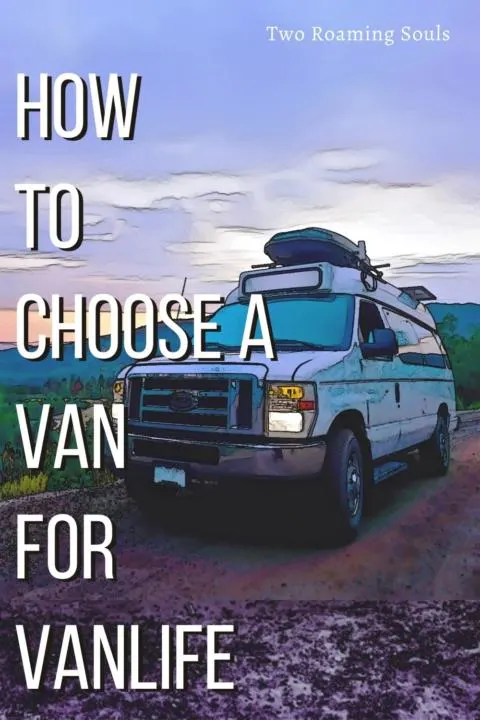
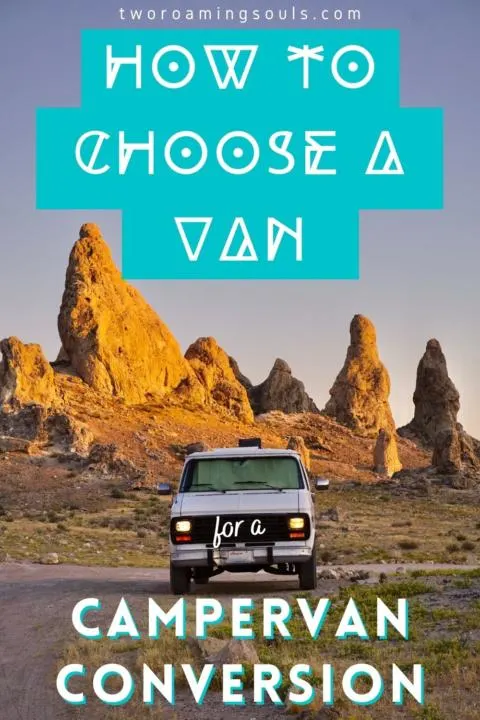



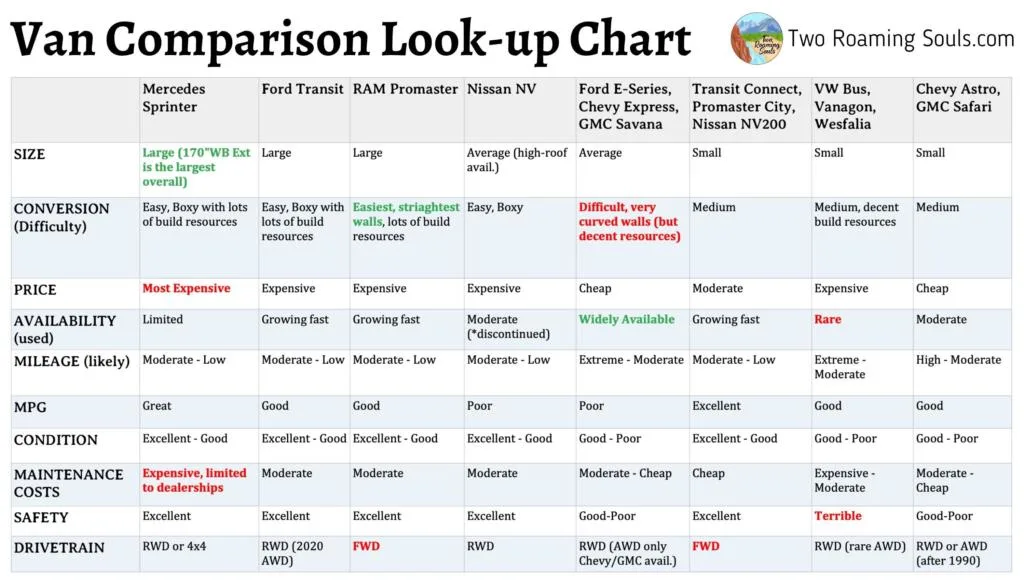
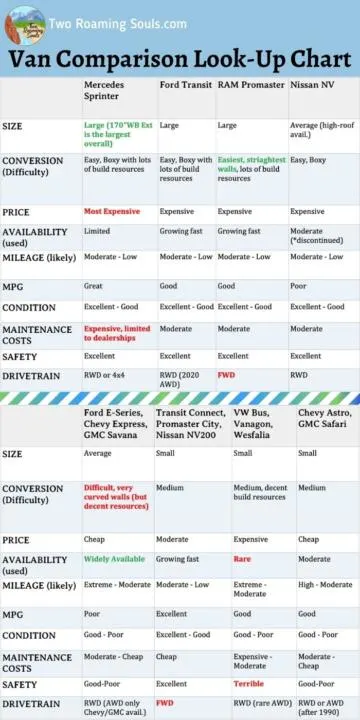
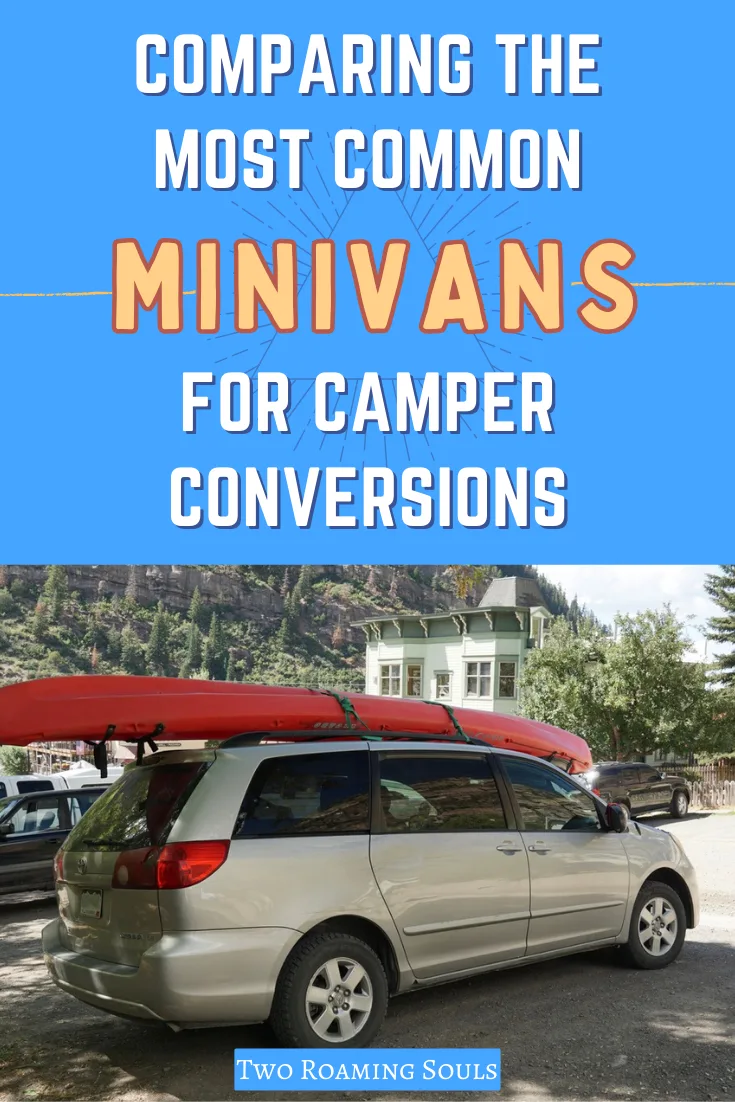
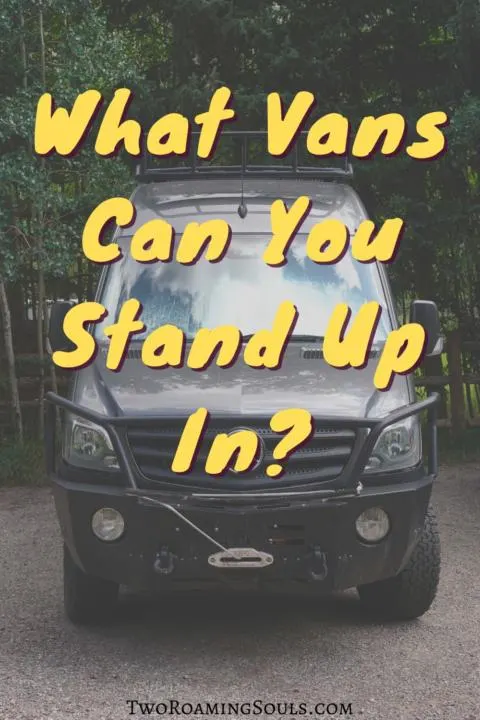
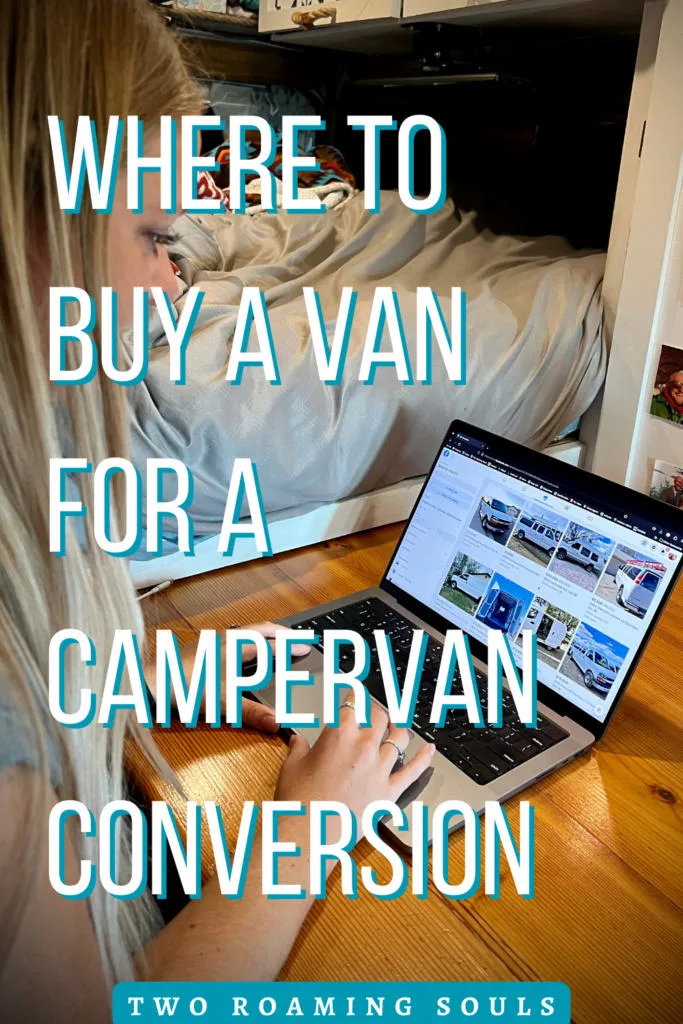
How Much Does A Professional Camper Van Conversion Cost? - tworoamingsouls
Saturday 15th of April 2023
[…] are many things to consider when choosing the right van for a camper van conversion. Such as high roof vs low roof, used van vs new van, are you using it full time or part time, do […]
Van Towing Ratings | How Much Can A Campervan Tow? - tworoamingsouls
Friday 7th of April 2023
[…] If you know how much weight you need to tow, then that helps narrow down your options. While van towing is not always the first thing on a buyer’s mind, it may inform your decision when choosing a van for a campervan conversion. […]
Is It Cheaper To Live In A Campervan | Everything You Need To Know - tworoamingsouls
Thursday 6th of April 2023
[…] […]
2023 Ford Transit Trail | Is This Upfit-Ready Campervan Worth It For Vanlife? - tworoamingsouls
Wednesday 1st of March 2023
[…] So what does it cost for all these vanlife-specific features? And are they going to be enticing enough for people looking to choose the perfect van? […]
How To Buy A Used Campervan For Sale By Owner - tworoamingsouls
Friday 18th of March 2022
[…] If you are looking to buy an empty used van to do your own complete conversion, then read my post about How To Choose A Van For A Campervan Conversion. […]